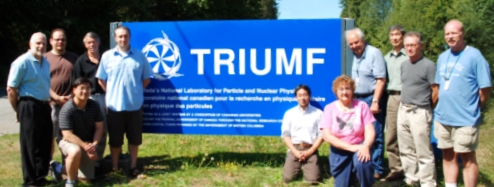
An international team of scientists working at Brookhaven National Laboratory recently announced new observations of the decay of a certain subatomic particle that has the potential to challenge the Standard Model of particle physics. The experiment confronts the Standard Model because the observed rate of decay was found to be twice that of prediction.
In this experiment, unstable subatomic particles called “K mesons” are used. K mesons only exist for 12 billionths of a second before decaying. A detector, about as large as a small house, was built to look for a rare type of K meson by sifting through trillions of decays.
This exceptional breakthrough was made possible through key contributions by TRIUMF. The experiment features new techniques that enables detection of one of the rarest decay processes. TRIUMF provided detection equipment, electronics, and computing and analysis expertise. TRIUMF graduate student, Joss Ives under supervision of experiment co-spokesperson Douglas Bryman, UBC professor and J.B. Warren Chair, worked on the data processing and analysis of the experiment with TRIUMF scientists including Toshio Numao and Rene Poutissou.
The experiment discovered an extremely rare form of disintegration of K mesons into three other particles: an observed positively-charged pion, and an unseen neutrino-antineutrino pair. This process is predicted by the Standard Model to occur only once in every 12 billion decays, but the experiment found the disintegration to occur almost twice as predicted, though still statistically consistent with the Model.
The current result detected three additional events, which brings the total of observed events to seven. Significant differences between the observed rate and the prediction could indicate new physical effects not accounted for in the Standard Model. The paper describing the new results has been submitted to Physical Review Letters.
However, scientists are not celebrating quite yet; greater precision of the measurement is needed for confirmation. Further study of this reaction will have to wait for a new set of experiments in Europe or at a new accelerator in Japan where the Brookhaven experimental apparatus is planned to be sent.
Seventy scientists from Canada, Japan, Russia and the United States have been searching for these decays for more than a decade. This research was funded by the US Department Of Energy’s Office of Science, the Natural Sciences and Engineering Research Council of Canada, the National Research Council of Canada, and through US-Japan and US-Russia joint funding programs for collaborative research in high-energy physics.
For technical background, please visit this website.
For Brookhaven’s announcement, please see the Brookhaven website.
By Nicole Dublanko
TRIUMF's Communications Assistant
